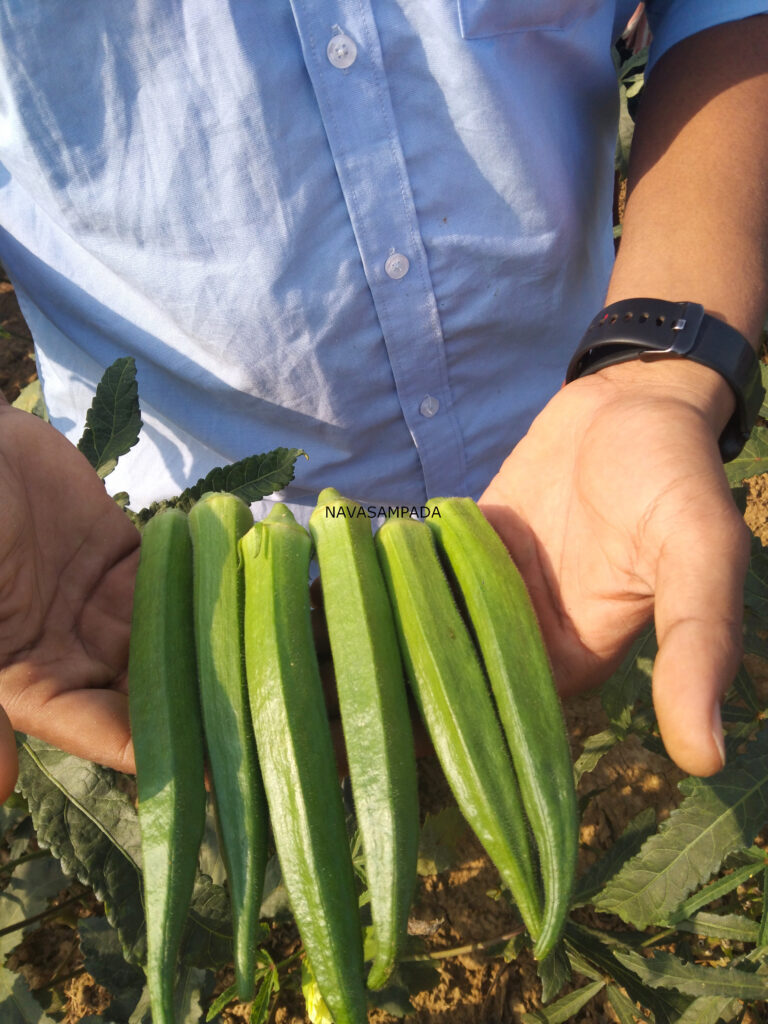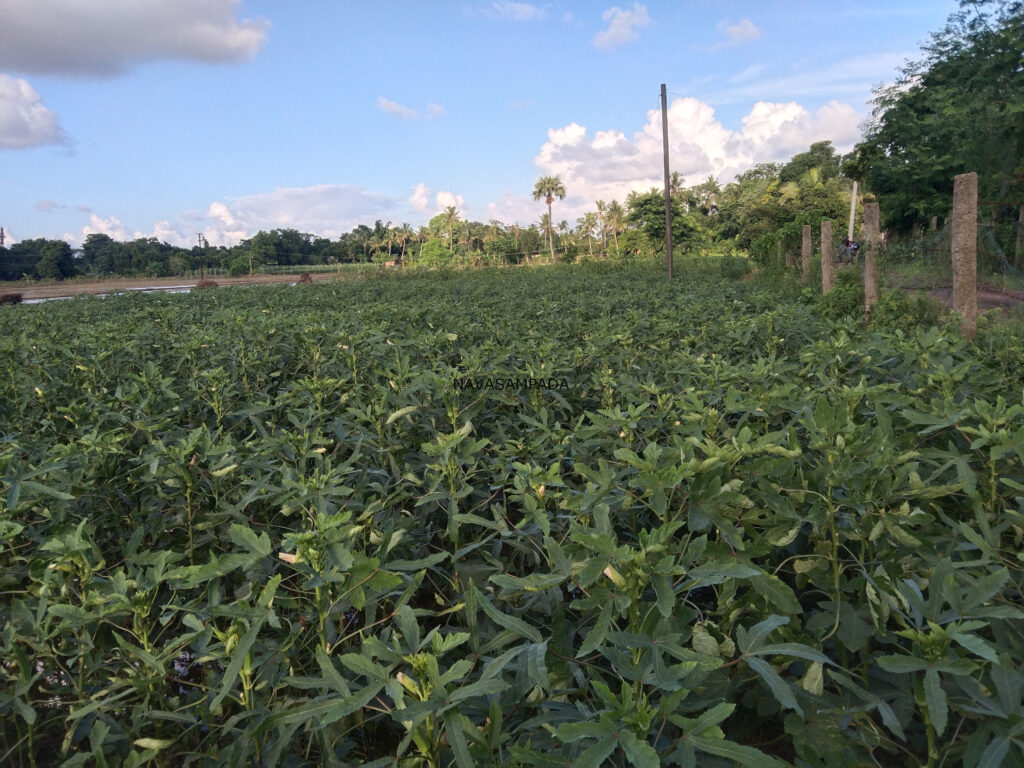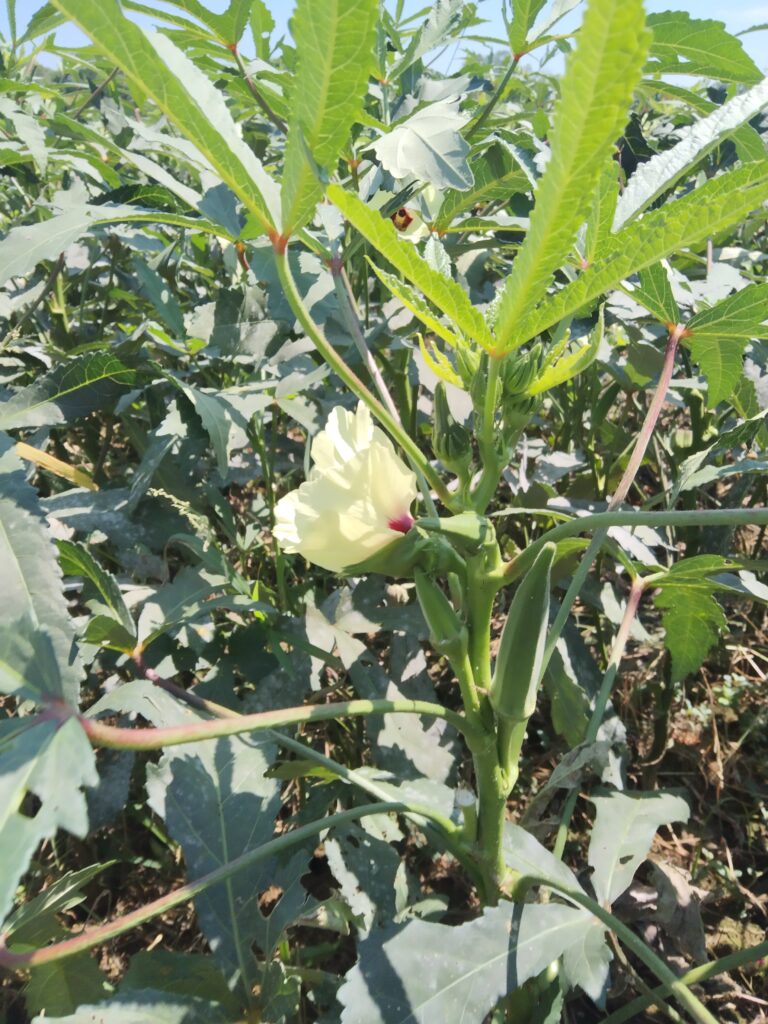lady’s finger is a warm season vegetable known for its edible green pods. It thrives in tropical and subtropical climates, making it a great choice for home gardeners and commercial growers alike.
Here’s a comprehensive, easy to follow guide to help you grow okra successfully.
1. Choosing the Right Variety
lady’s finger comes in different varieties, each with unique characteristics. When selecting a variety, consider factors like climate, soil type, and market demand. Popular varieties include:
Clemson Spineless: Known for tender, spineless pods.
Jamboree: Disease Resistant and high yielding.
Annie Oakley II: Great for hot, southern climates.
Pick a variety suited to your specific needs and growing conditions.



2. Preparing the Soil
lady’s finger requires well drained, fertile soil for healthy growth. Here’s how to prepare your soil:
- Test Soil pH: Check the pH level (aim for 6.0 to 7.0) and adjust if needed.
- Clear the Land: Remove weeds and plant debris.
- Loosen the Soil: Use a plow or garden fork to till the soil to a depth of 1218 inches.
- Add Organic Matter: Mix in compost or well rotted manure to enhance soil fertility and structure.
- Ensure Good Drainage: If the soil is heavy or poorly drained, raise planting beds or hills to improve water movement.
3. Planting Okra Seeds
grows best when directly sown in the ground since it doesn’t transplant well. Follow these steps for optimal planting:
Timing: Wait until the soil temperature is above 65°F (18°C), and all danger of frost has passed.
Spacing: Plant seeds about 1 inch deep, spacing them 12–18 inches apart in rows 34 feet apart. For raised beds or hills, plant 3–4 seeds per hill and thin to 23 plants after germination.
Watering: Water gently after sowing to help the seeds settle. Keep the soil consistently moist until the seeds germinate (510 days).
4. Caring for the Plants
Once your lady’s finger seeds have germinated and seedlings emerge, take these steps to ensure healthy growth:
Thinning: Thin plants to maintain 12–18 inches of space between each one. This improves air circulation and reduces disease risk.
Mulching: Apply mulch around the plants to conserve moisture, regulate temperature, and control weeds.
Watering: Water regularly, especially during dry spells. Deep watering is best to encourage strong root growth, but avoid wetting the leaves to prevent fungal infections.
Fertilizing: lady’s finger is a heavy feeder. Apply a balanced fertilizer (e.g., 10-10-10 NPK) at planting. Then, sidedress with additional fertilizer every 4-6 weeks during the growing season, depending on the plant’s needs.
Weeding: Keep weeds in check, especially early on. As okra grows, the plant’s shade helps reduce weed competition.
5. Managing Pests and Diseases
lady’s finger is susceptible to pests and diseases, but with proper monitoring and care, you can manage these issues effectively:
Common Pests:
- Aphids: Control with insecticidal soap or neem oil.
- Flea Beetles: Use row covers or insecticides.
- Caterpillars: Handpick or apply Bacillus thuringiensis (Bt), a biological pesticide.
- Root-Knot Nematodes: Rotate crops and amend soil with organic matter to reduce nematode populations.
Common Diseases:
- Powdery Mildew: Remove infected leaves and apply fungicides as necessary.
- Leaf Spot: Prevent by ensuring good air circulation between plants. Apply fungicides if needed.
6. Harvesting
lady’s finger is usually ready for harvest about 50–60 days after planting. Here’s how to harvest it at the right time:
Timing: Harvest when the pods are young and tender, around 2–4 inches long. If left too long, they become tough and fibrous.
Method: Use a sharp knife or garden scissors to cut the pods from the plant, leaving about ½ inch of stem attached. Wear gloves to protect yourself from the plant’s fine hairs.
Frequency: Harvest every 2–3 days to encourage continuous production and prevent overripening.
7. Postharvest Handling
Proper handling and storage can extend the shelf life of your okra:
Sorting: Sort the okra by size and remove any damaged or overripe pods.
Storage: Store fresh okra in a cool, dry place. It can be kept in the refrigerator for up to a week. For long term storage, blanch and freeze okra.
Market: If selling, pack okra in clean, ventilated containers to maintain freshness during transport.
8. Crop Rotation and Soil Health
Okra is a heavy feeder, meaning it uses a lot of nutrients from the soil. To maintain soil health and avoid nutrient depletion:
Crop Rotation: Rotate with nitrogen fixing crops like legumes to replenish the soil.
Soil Amendments: Continue adding organic matter or compost to maintain soil fertility.
9. Additional Tips for Success
Monitor Regularly: Keep an eye out for pests, diseases, and growth issues.
Stagger Plantings: For continuous harvest, plant okra seeds every 3–4 weeks throughout the growing season.
Support Tall Varieties: Some okra plants grow tall and may require staking to prevent lodging during windy conditions.
Nutritional Value
- Vitamins: Okra is a great source of vitamin C, vitamin K, and vitamin A.
- Minerals: It provides important minerals like magnesium, potassium, and calcium.
- Fiber: It is high in dietary fiber, which helps with digestion and maintaining healthy blood sugar levels.
- Antioxidants: Contains compounds such as flavonoids, polyphenols, and carotenoids, which have anti-inflammatory and antioxidant properties.
Health Benefits
- Digestive Health: The fiber content in bhendi helps maintain regular bowel movements and supports gut health. The mucilage (a gelatinous substance) in okra also acts as a natural laxative, easing constipation.
- Blood Sugar Regulation: Okra has been shown to help lower blood sugar levels, which is particularly beneficial for people with diabetes.
- Heart Health: The potassium and fiber in okra contribute to maintaining healthy blood pressure and reducing cholesterol levels, which supports cardiovascular health.
- Anti-inflammatory and Antioxidant: The antioxidants and anti-inflammatory compounds in okra may help reduce oxidative stress in the body, supporting overall health and potentially reducing the risk of chronic diseases.
Ways to Eat Okra
Okra is quite versatile and can be prepared in a variety of ways:
- Fried: One of the most popular methods in Southern cuisine. The okra is often breaded and deep-fried, resulting in a crispy texture.
- Stewed or in Gumbo: lady’s finger is a key ingredient in gumbo, a traditional Louisiana dish. It thickens the broth and adds a unique texture.
- Grilled: Cut bhendi pods can be tossed with olive oil, seasonings, and grilled for a smoky flavor.
- Roasted: Roasting bhendi in the oven with some spices brings out its natural sweetness while giving it a crispy texture.
- Pickled: lady’s finger can be pickled and enjoyed as a tangy snack or side dish.
- Stir-fried or Sautéed: Quick stir-fries with other vegetables or meats make for a tasty side dish.
- In Soups or Stews: The mucilaginous (slimy) quality of okra makes it a natural thickening agent in soups, stews, or curries.
Texture and Flavor
lady’s finger has a unique texture: it is somewhat slimy when cooked, which is due to the mucilage it contains. Some people enjoy this texture, while others might find it off-putting. The flavor of okra is relatively mild, with a slightly grassy, earthy taste that pairs well with a wide variety of spices and ingredients.
How to Prepare
- Washing and Cutting: When preparing bhendi, it’s best to wash it thoroughly and then cut off the tops of the pods. You can slice them into rounds or leave them whole, depending on your recipe.
- Reducing the Sliminess: To reduce the slimy texture, some people recommend avoiding stirring the okra too much during cooking or cooking it over higher heat. Another tip is to add acidic ingredients (like lemon juice or vinegar) to help cut down on the slime.
Popular Dishes Featuring Okra
- Gumbo: A famous Creole dish that often includes bhendi as a thickening agent alongside other vegetables, meat, or seafood.
- Bhindi Masala: A popular Indian dish where bhendi is sautéed with onions, tomatoes, and spices.
- Okra and Tomatoes: A simple Southern dish where okra is cooked with tomatoes and seasonings, often served as a side dish.
- Okra Fritters: Fried bhendi mixed with batter or cornmeal for a crispy treat.
Conclusion
lady’s finger farming can be a highly rewarding endeavor, whether for personal consumption or commercial production. With the right variety selection, proper soil preparation, and regular care throughout the growing season, you can enjoy a bountiful harvest. Follow these steps to ensure healthy growth, manage pests and diseases effectively, and harvest your okra at its peak for the best quality and yield.